Are tiny bugs buzzing around your fruit bowl or kitchen sink? You might be dealing with fruit flies! Don’t worry, these common household pests are easily managed without breaking the bank or requiring harsh chemicals. In fact, you probably have everything you need to get rid of them right in your kitchen.
Recently, we experienced a fruit fly invasion at home – a first in over four years! Determined to tackle the issue, I decided to test seven different fruit fly elimination methods. Yes, spreadsheets and copious notes were involved! Today, I’m sharing the most effective DIY fruit fly traps and how to make them using simple, natural ingredients you likely already have.
These homemade traps are incredibly easy to create, chemical-free, and offer humane options if you prefer to release the fruit flies outdoors rather than eliminate them. We’ll also cover essential tips to prevent future fruit fly infestations from taking hold in your home.
Understanding Fruit Flies
Fruit flies are small, winged insects known for their attraction to ripe and fermenting fruits and vegetables – hence their name. They are also drawn to sugary substances like beer, wine, and juice. You’ll often find them congregating around fruit bowls, garbage disposals, trash cans, and even drains in your kitchen.
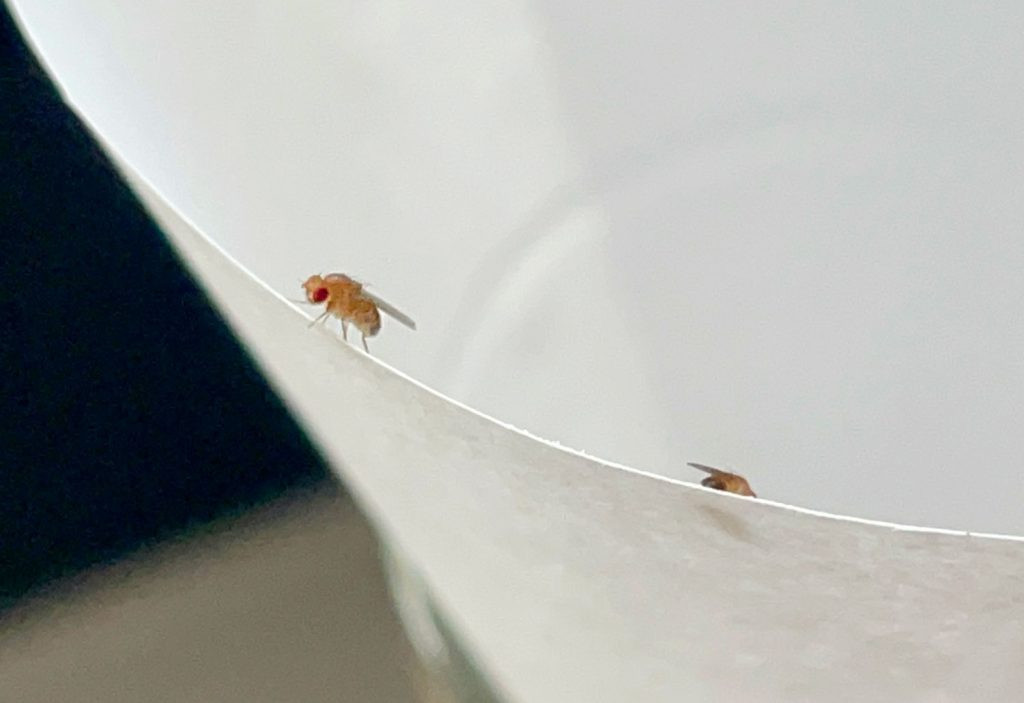 Close Up Of Fruit Fly On Paper Funnel
Close Up Of Fruit Fly On Paper Funnel
Alt Text: Detailed close-up of a fruit fly with red eyes resting on a white paper funnel, illustrating the small size and distinct features of these common kitchen pests.
Fruit flies are tiny, about the size of a grain of rice, and resemble small, tan or brownish houseflies with distinctive red eyes. They are most prevalent during warmer months, particularly summer and late fall, when fruits are abundant.
A fruit fly problem can start with just a few individuals entering your home, perhaps hitching a ride on fresh produce from the grocery store. However, female fruit flies are prolific breeders, capable of laying hundreds of eggs in their short lifespan. These eggs can hatch in as little as 12 hours, and the flies can reach adulthood within a few days. This rapid reproduction cycle means a small number of fruit flies can quickly escalate into a significant infestation, making prompt action crucial.
Identifying Fruit Flies: Fruit Flies vs. Fungus Gnats vs. Drain Flies
It’s easy to mistake fruit flies for other small flying insects commonly found in homes, especially fungus gnats and drain flies. While all are small and annoying, correctly identifying the pest is key to choosing the most effective elimination method. The easiest way to distinguish them is by observing where you see them and what larger insect they most resemble.
- Fruit Flies: Resemble tiny flies and are typically found near fruit bowls, open trash cans, or any source of fermenting food or sugary spills.
- Drain Flies: Look like small, fuzzy moths and are usually seen near sinks, drains, and damp areas.
- Fungus Gnats: Resemble small mosquitoes and are typically found around houseplants, as they breed in moist potting soil.
If you are unsure which pest you are dealing with, you can try one of the DIY traps described below. If the trap attracts the insects, you likely have fruit flies.
4 Simple DIY Fruit Fly Traps Using Household Items
Getting rid of fruit flies doesn’t require complex solutions or expensive products. All you need are a few common household items and a bit of patience. The basic principle behind each trap is the same: attract the fruit flies and then prevent their escape. We tested the following four DIY methods and found a clear winner. Since each method utilizes items you probably already have at home, trying more than one is easy and worthwhile. Consider it a fun, mini-science experiment in your kitchen! Here are the first four methods I tested:
- Funnel Trap
- Plastic Wrap Trap
- Dish Soap Trap
- Rotting Fruit Trap
I’ll provide detailed instructions for each method below, along with our findings on their effectiveness. Keep in mind that some traps work faster than others, and it may take several days for any of these techniques to completely eliminate your fruit fly problem.
#1: The Paper Funnel Fruit Fly Trap
This trap design lures fruit flies into a container through a narrow opening at the bottom of a paper funnel. Once inside, the flies struggle to navigate back out through the small hole.
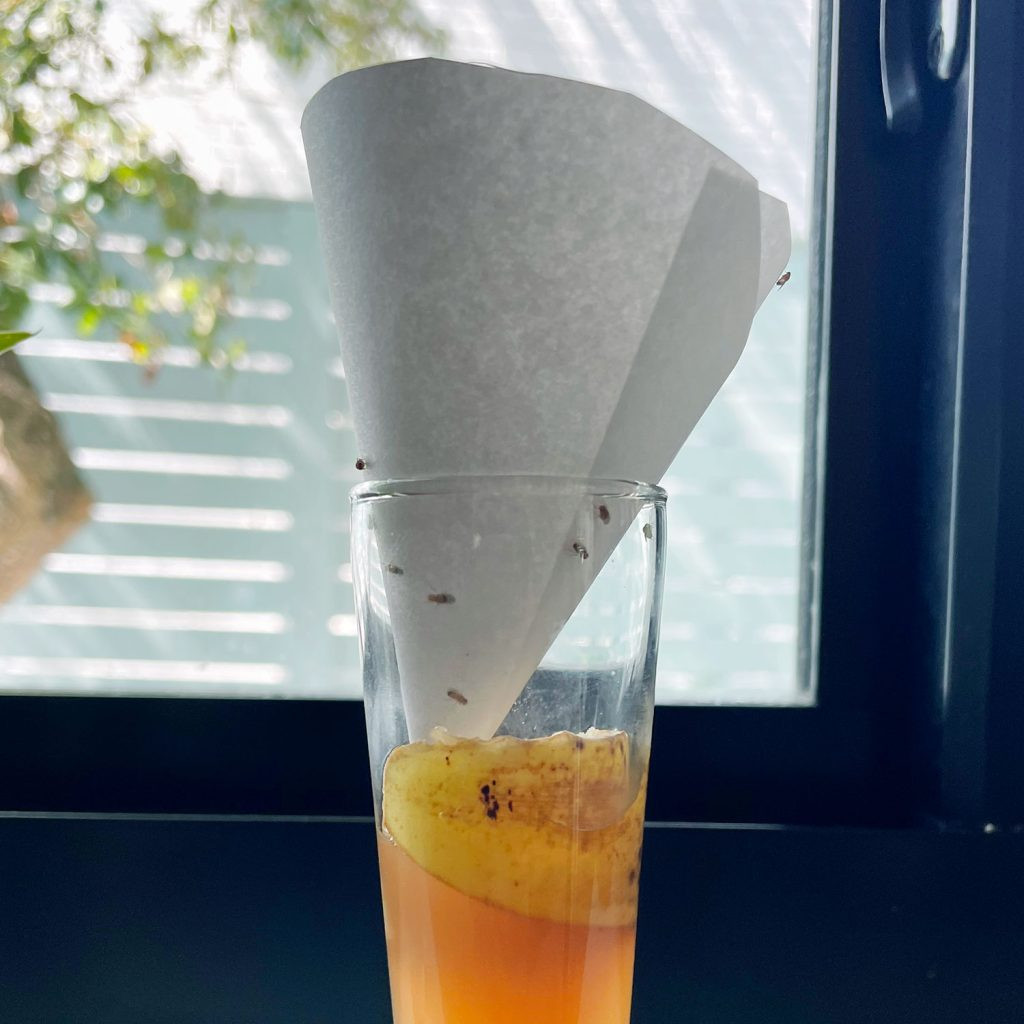 DIY Fruit Fly Trap With Paper Funnel
DIY Fruit Fly Trap With Paper Funnel
Alt Text: A clear glass jar fruit fly trap featuring a homemade paper funnel inserted into the opening, demonstrating a simple and effective DIY method for catching fruit flies.
Supplies needed:
- A small, clear jar, cup, or container – a narrow opening is preferable.
- A piece of paper or cardstock.
- Tape.
- Scissors.
- Apple cider vinegar (ACV).
Instructions:
- Choose your container: Select a small, clear container like a clean food jar or a plastic bottle. A narrow opening helps improve the trap’s effectiveness.
- Add apple cider vinegar: Pour a small amount of apple cider vinegar, old beer, or wine into the bottom of the container. The enticing scent will attract the fruit flies.
- Make your funnel: Shape a piece of paper or cardstock into a cone with a very small opening at the tip. Secure the cone shape with tape. You can trim the opening at the tip after forming the cone if needed; it only needs to be about the size of a grain of rice.
- Set up your funnel: Place the paper cone into the opening of your container, with the narrow tip pointing down. You may need to adjust the funnel shape so it sits securely on the container’s opening without touching the vinegar. Ensure it seals against the edges to prevent flies from escaping through gaps.
- Humane removal option (optional): To release the trapped fruit flies outdoors, carefully carry the entire trap outside without disturbing the funnel (to prevent escape). Remove the funnel outdoors and allow the flies to fly away.
While you can use a store-bought funnel, the opening is often too wide, allowing trapped fruit flies to escape. A homemade paper funnel provides a more effective, narrow opening.
#2: The Plastic Wrap Fruit Fly Trap
Similar to the funnel trap, this method attracts fruit flies with the smell of apple cider vinegar. Fruit flies enter the trap through tiny holes poked in a plastic wrap cover, but then struggle to exit.
Supplies needed:
- A small, clear jar, cup, or container.
- A rubber band.
- Plastic wrap or a plastic bag.
- A toothpick.
- Apple cider vinegar (ACV).
Instructions:
- Choose your container: Select a small, clear jar, cup, or any glass container. Clarity helps you monitor your trap’s success, but even an old can will work.
- Add apple cider vinegar: Pour apple cider vinegar into the container. Its scent is the primary attractant. Old beer or wine also work well, but avoid using regular white vinegar as it’s less effective.
- Cover with plastic wrap: Tightly stretch plastic wrap over the container opening and secure it with a rubber band. Saran wrap is ideal, but you can also use a piece cut from a plastic bag.
- Poke small holes: Use a toothpick to carefully poke several small holes in the plastic wrap. You don’t need many, just enough for fruit flies to enter. Ensure the holes are large enough for a fly to pass through.
- Humane removal option (optional): To release the trapped flies, carefully take the trap outside without removing the plastic wrap. Once outside, remove the plastic wrap and let the flies escape.
Alternatively, you can create a similar trap by puncturing holes in a metal jar lid using a hammer and nail. Mason jars or old food jars with metal lids are suitable for this variation.
#3: The Dish Soap Fruit Fly Trap
This trap differs from the previous two as it doesn’t require a cover. Instead, it uses dish soap to break the surface tension of the liquid, trapping the flies. Note: This method is not designed for humane release, as the soap will coat the flies.
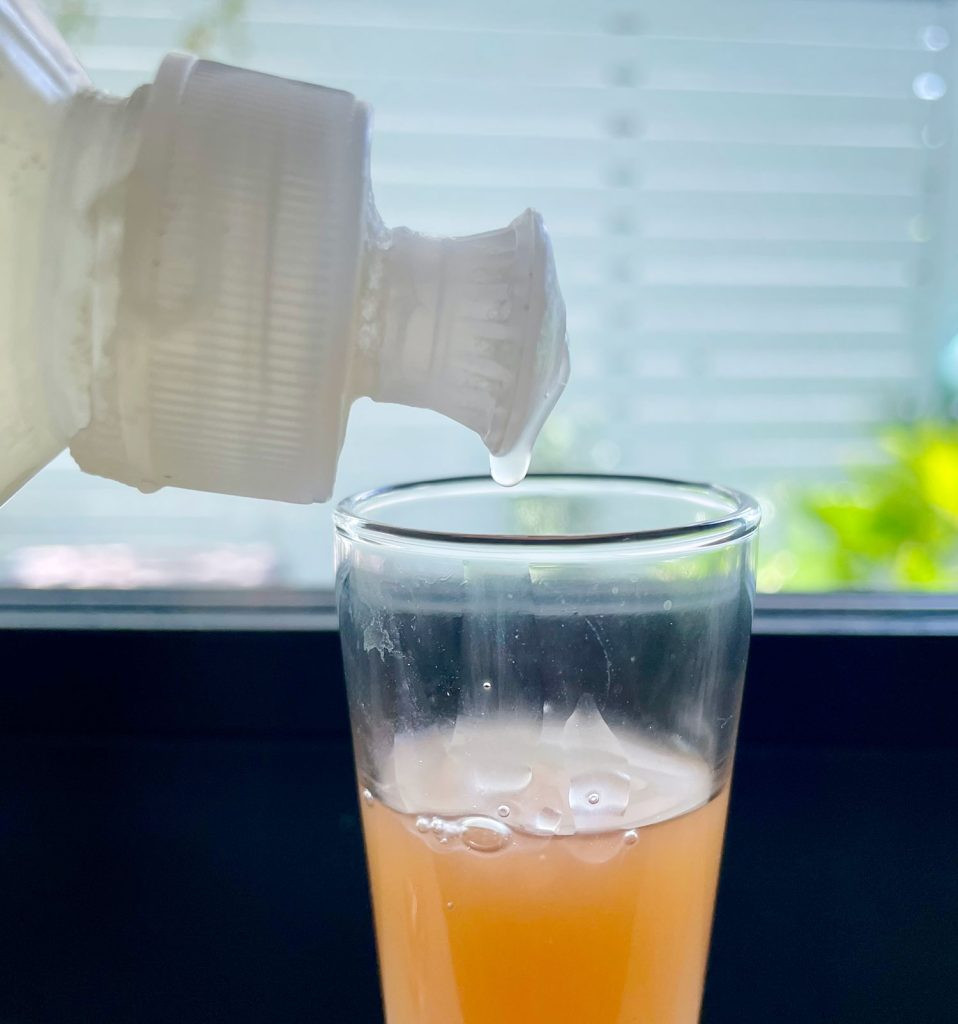 Dripping Dish Soap Into Apple Cider Vinegar For DIY Fruit Fly Trap
Dripping Dish Soap Into Apple Cider Vinegar For DIY Fruit Fly Trap
Alt Text: Close-up shot of dish soap being added to apple cider vinegar in a clear bowl, illustrating the simple preparation of a dish soap fruit fly trap.
Supplies needed:
- A small container, bowl, or dish.
- Dish soap.
- Apple cider vinegar (ACV).
Instructions:
- Pour apple cider vinegar: Fill the bottom of a small container, bowl, or dish with apple cider vinegar. The scent will attract the fruit flies.
- Add dish soap and mix: Add several drops of dish soap to the apple cider vinegar and gently mix to create a soapy solution. The soap reduces the surface tension, causing flies that land on the mixture to become trapped and sink.
This technique can also be combined with the plastic wrap or funnel methods. Adding dish soap to the apple cider vinegar before covering the top provides an additional way to trap the flies.
#4: The Rotting Fruit Fruit Fly Trap
We also experimented with traps that replaced apple cider vinegar with fruit, which is highly attractive to fruit flies.
Supplies needed:
- A small glass jar, cup, or container.
- Plastic wrap or paper funnel (depending on your chosen trap mechanism).
- A small piece of ripe or overripe fruit, such as a banana peel or apple slice.
To create a rotting fruit trap, simply substitute apple cider vinegar with a piece of banana peel, apple slice, or peach in either the Plastic Wrap Trap or Funnel Trap setup. You can also add a fruit scrap in addition to apple cider vinegar to enhance the lure. Be sure to replace the fruit scrap every day or two to prevent unpleasant odors in your kitchen.
Determining the Best Fruit Fly Trap
As you can see in the photos, we set up four different DIY traps to compare their effectiveness. The four homemade traps we tested were variations of the techniques described above:
- Plastic Wrap Trap with banana peel.
- Funnel Trap with ACV and banana peel.
- Plastic Wrap Trap with ACV and dish soap.
- Dish Soap Trap with ACV only.
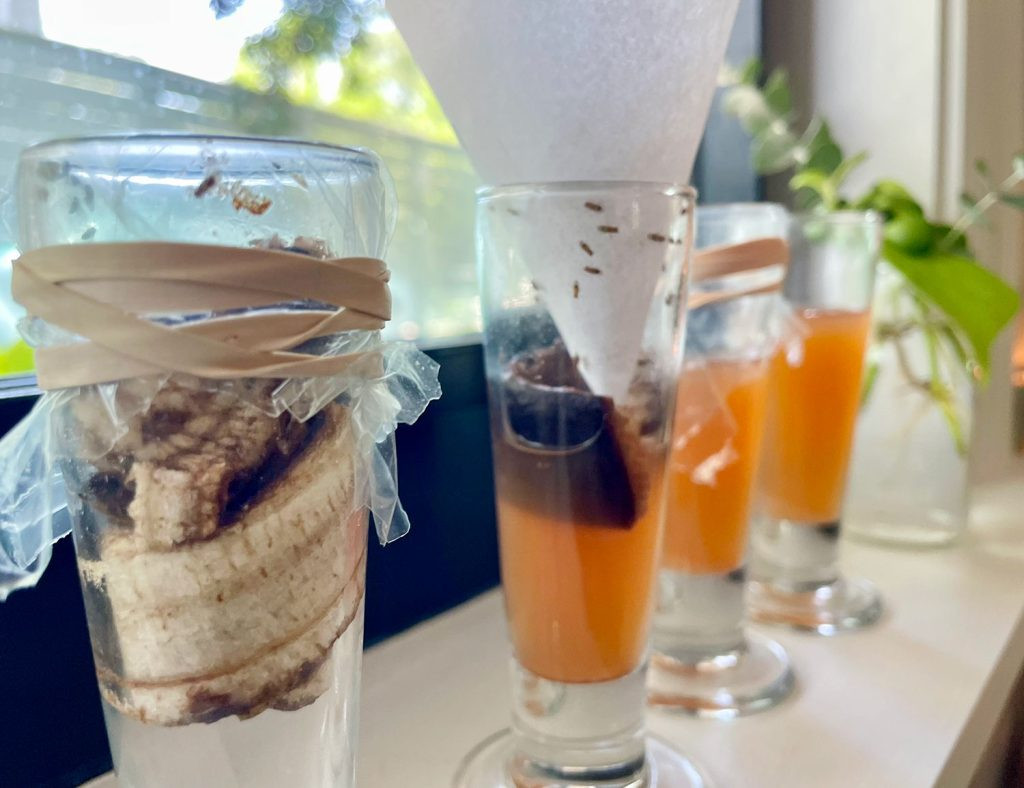 4 DIY Fruit Fly Traps Close Up
4 DIY Fruit Fly Traps Close Up
Alt Text: A lineup of four homemade fruit fly traps in clear containers, showcasing different DIY methods and bait options used in a side-by-side comparison test for effectiveness.
Our results indicated that the type of lure was more significant than the trap design. Traps using banana peel performed significantly better than those using only apple cider vinegar. The two Plastic Wrap Traps were nearly identical in design, but the one baited with banana peel dramatically outperformed the one with ACV and soap. Perhaps apple cider vinegar is less appealing when fresh fruit is nearby?
Based on our experiment, we recommend adding a fruit scrap to any trap you set up. We slightly preferred the plastic wrap trap for its ease of construction and stability. We accidentally knocked over the funnel trap once, releasing some trapped flies back into the kitchen – oops!
What Lures Fruit Flies Most Effectively?
Our initial results sparked further curiosity, leading to another experiment to determine the most attractive fruit bait. We tested three readily available fruits: banana peel, apple slices, and a strawberry, each placed in a Plastic Wrap Trap and set out side-by-side for 24 hours.
While the banana peel initially seemed promising (it was the ripest at the start), the fruit flies were ultimately most attracted to the strawberry. The banana peel still caught a number of flies, but the strawberry became increasingly effective as it ripened further. Surprisingly, the apple slices didn’t catch a single fruit fly!
Store-Bought Fruit Fly Traps: A Convenient Alternative
If DIY solutions aren’t working for you, or if you prefer a more convenient option, several effective store-bought fruit fly traps are available. These traps have thousands of positive reviews and are generally priced under $20. They may be worth considering if you need to trap other types of flying insects or prefer a more discreet solution than homemade traps.
 Collage of Storebought Fruit Fly Traps
Collage of Storebought Fruit Fly Traps
Alt Text: A product collage featuring various store-bought fruit fly traps, showcasing commercially available solutions for managing fruit fly infestations in homes.
During our experiments, I purchased a pack of Terro Fruit Fly Traps to compare their performance against our homemade traps. I placed a Terro trap alongside our banana and strawberry traps for 24 hours to compare their effectiveness.
Again, our homemade strawberry trap performed best, closely followed by the homemade banana peel trap. The store-bought trap only caught a single fly in the initial 24-hour period. HOWEVER…
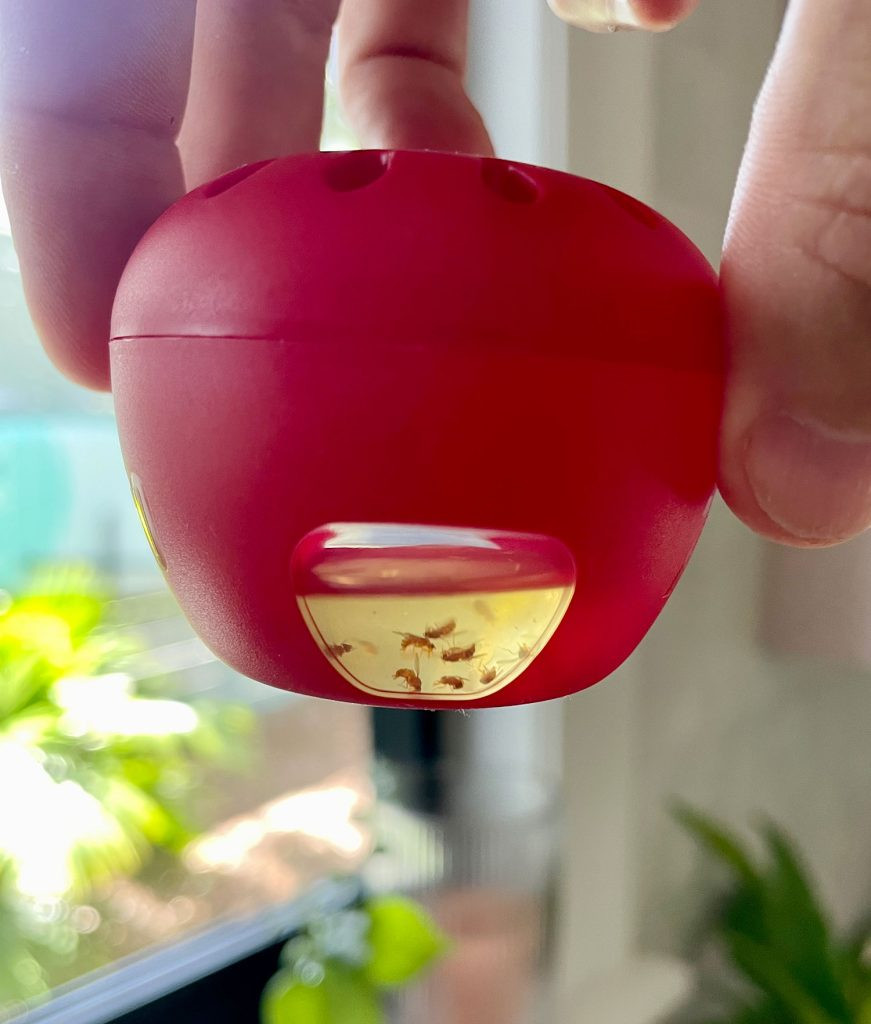 Terro Fruit Fly Trap With Dead Fruit Flies Visible
Terro Fruit Fly Trap With Dead Fruit Flies Visible
Alt Text: A Terro brand store-bought fruit fly trap filled with dead fruit flies, demonstrating its effectiveness over time in catching and eliminating these household pests.
To ensure a fair test, we discarded our DIY traps and left the store-bought trap out for another 24 hours. Over this extended period, the Terro trap effectively captured a significant number of fruit flies, as shown above. So, store-bought traps definitely work, although they might not be as immediately effective as our best homemade traps.
Our conclusion? Store-bought traps are a good option if you prefer a more discreet solution, especially for long-term placement. However, homemade traps are incredibly effective for quickly reducing fruit fly populations, and we found them to be the best way to get rid of fruit flies fast!
Preventing Fruit Flies: Proactive Measures
While eliminating fruit flies is relatively simple, preventing them from infesting your home in the first place is ideal. Here are some straightforward steps you can take to prevent fruit flies from becoming a household nuisance:
- Maintain clean kitchen surfaces: Regularly wipe down kitchen counters, stovetops, tables, and any surfaces that might collect food residue or spilled liquids. Fruit flies are particularly attracted to fruit, sweet juices, and alcohol, so promptly clean up any spills.
- Empty your trash regularly: Food scraps left in your garbage can quickly become a breeding ground for fruit flies, especially in warmer weather. Take out your trash daily to minimize attractants.
- Dispose of overripe fruit promptly: Monitor your fruit bowl for browning or overly ripe fruits like apples and bananas. Discard them before they become a fruit fly magnet.
- Wash produce immediately after bringing it home: Washing fruits and vegetables as soon as you get them home from the store can remove any fruit fly eggs or larvae that may be present. (Note: Berries may spoil faster if washed before storing, so wash them just before use.)
- Store produce in the refrigerator when possible: Fruit flies do not thrive in cold environments. Refrigerating fruits and vegetables, especially ripe ones, can significantly reduce their attractiveness to fruit flies.
- Clean your sink drain regularly: Food particles and organic matter accumulating in your sink drain can attract fruit flies. Use your garbage disposal regularly and flush drains with hot water or a drain cleaner periodically to eliminate potential breeding sites.
Finally, if you do spot fruit flies in your home, don’t panic. While it’s important to act quickly to prevent the problem from escalating, the solutions outlined in this guide are easy, effective, and fast-acting. You might even find yourself enjoying a bit of “fruit fly science” in the process, just like I did!
*This post contains affiliate links, so we may earn a small commission when you make a purchase through links on our site at no additional cost to you.
